The weather was reasonable this Wednesday, when Dave Weaver and I met a big, big group. The invitation said lots of Snowy Owls, so what do you know? People showed! Let’s cut to the chase. From the same spot, we saw two Snowy Owls out in the marsh. But here is the very best part — these days, there are “sirens” on the birding grounds; they call to us by pointing giant lenses at birds. Sometimes it is a Red-tailed Hawk, other times it is something a bit more exotic. So the question is, do we stop and disgorge a large group to look at every single thing the photographers flock to? It’s one of those trip leader questions. But what we do know is that sometimes we want to find our own perched raptors. That was the charge to the group on Wednesday, and John Cannizzo did it! There was a lovely Snowy Owl near the small pannes, close enough to see which way it was looking. Another one sat next to the straits farther out. This coincidence did give a sense of abundance. We know that there will be larger irruptions some years, most likely when prey is abundant for breeding. It is very reassuring to see lots of these magnificent birds on our marsh.

Snowy Owl – Patti Wood
We scurried on to parking lot #7 to look at Emerson Rocks, as the tide was rising. Tom Wetmore and Dave Adrien were departing the boardwalk, and challenged us to find a Purple Sandpiper among the many Dunlin on the fast-disappearing rocks. We found the sandpipers perched on the tips of the rocks, acting like they were playing that game of “hot lava” we loved as kids as their safe spot shrank. Why didn’t they just fly off to a mudflat? They clung as long as seemed possible until they all took off, Dunlin only, no Purples. Sanderlings flew by with Dunlin as well. The sea was relatively empty, with only one Common Loon, a handful of Common Eiders and White-winged Scoters, and small groups or singletons of other sea duck species. We did find a couple of pairs of Common Goldeneyes, which we are looking for with growing impatience.
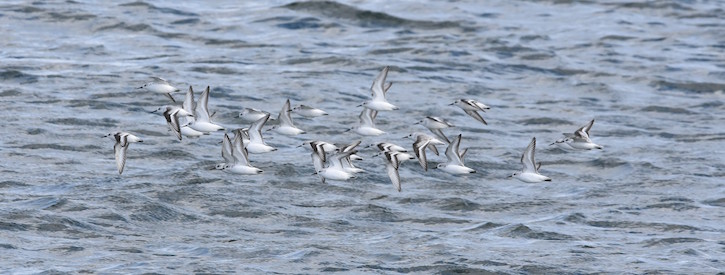
Sanderlings in Flight – Susan Balser
We departed the south end with plenty of time to see the rest of the island, which is what we did. A big group of Northern Pintails rested with Mallards in a panne just south of Cross Farm Hill. Remember reading about some of the spectacular displays of avian diversity and abundance we’ve seen off of Hellcat Dike? This was that other kind of day. The northwest wind rose and sapped our warmth, and the marsh looked empty. Bill Forward Pool was frozen, supporting one Herring Gull who may or may not have been picking at the carcasses of carp poking out of the ice. A Great Black-backed Gull went by and didn’t have to call “Dull!” as they do on a hot summer afternoon. If you looked at it right, the empty place that can be so full of life was like the barren branches on the solstice trees, empty for now, but ready to be filled some other day. Most (none?) of us didn’t make it to that perspective and slunk back to the vans, hoping something would happen somewhere else. Passing the restrooms, though, we alerted a new birder to the nest of our beloved Baltimore Oriole, “Champ,” hanging proudly in the cherry trees.
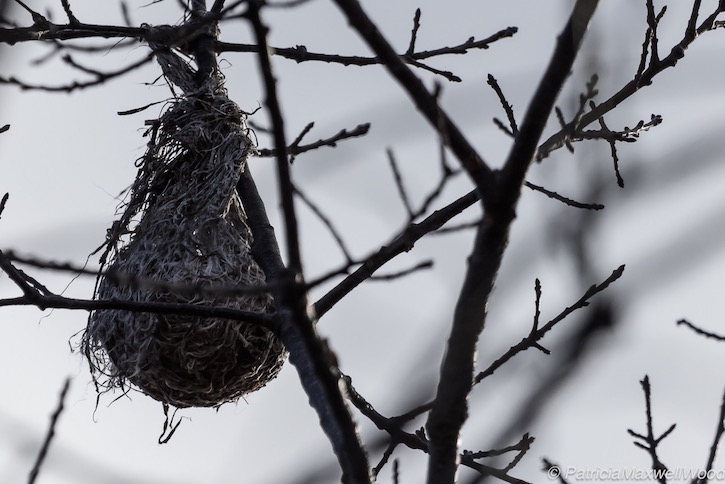
Baltimore Oriole nest – Patti Wood
As we headed north out of the Hellcat area, someone said that the strangely wintering White-eyed Vireo had been seen at The Warden’s and I made a spur-of-the-moment decision to try for passerines there. It took about 45 seconds, much less than it took everyone to get out of vans and begin searching, to see that the bushes there were devoid of birds, with nothing but the northwest wind doing its best to destroy us. How long to wait before sending everyone back to the vehicles? Then Christina, one of our newer birders and the only person looking up, said “What’s that?”, redirecting us towards a lovely Bald Eagle passing high overhead. We did pause for good looks at more than one Northern Harrier as we passed back through the North Field area and North Marsh and picked up a few American Tree Sparrows and other incidentals along the road.
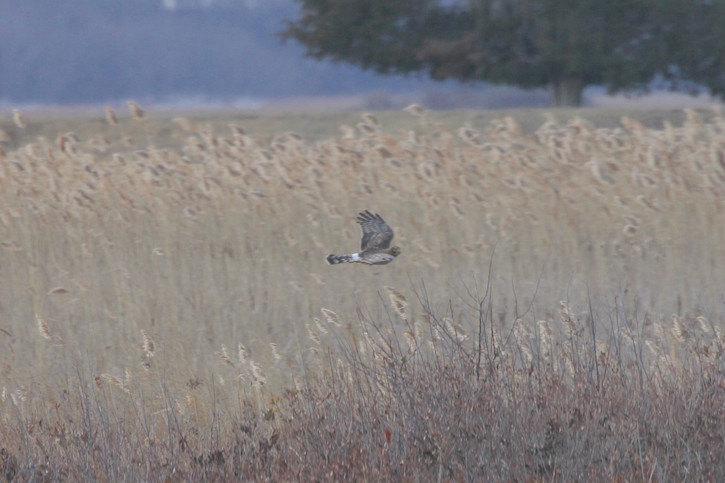
Northern Harrier over North Field – John Linn
The ocean off parking lot #1 was also rather empty, which made a giant raft of Black Scoters off of the nearest small jetty seem pretty special. Finally there were a couple of Red-throated Loons. A few of us saw a couple of small, fast black-and-white things that were most probably Razorbills, the day’s quiz bird! Then a tight flock of Sanderlings performed their low-over-the-beach spectacle and drew a crowd of us to the shore. The images below speak for themselves. Lisa Hutchings and some of her teachers, who had joined us, poked around in the wrack, wondering, as any real naturalist would, what the heck the Sanderlings were finding there. They found nothing. The images of the birds we received later showed that there was more tasty stuff there than meets the human eye!

Sanderlings in flight – Patti Wood
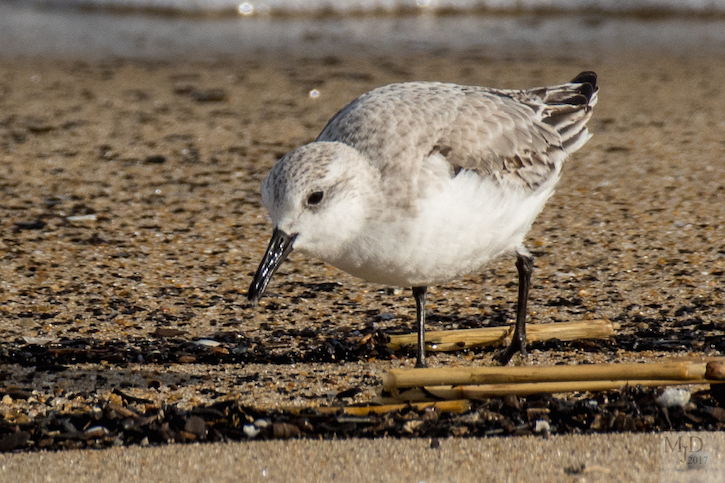
Sanderling with a morsel – Mike Densmore
With time for the north end, we headed through the developed part of the island, while the wind grew in intensity. By the time we reached that spot, exposed perfectly, one had to either cower or whoop with excitement for the tumult. And there were birds out there, more goldeneyes, scoters, loons, eiders, Red-breasted Mergansers flying by fast, and one swift, beautiful flock of Long-tailed Ducks. The image captures them perfectly.
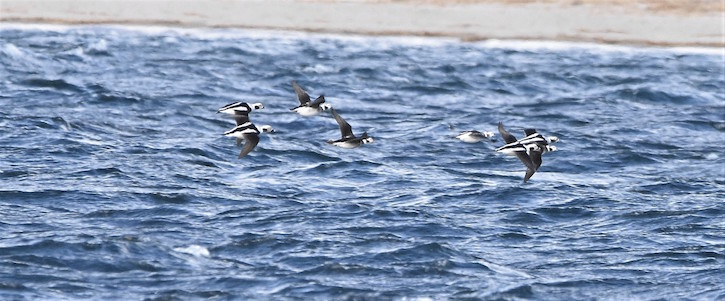
Long-tailed Ducks headed out to sea – Susan Balser
Thus ended a solid, if unremarkable Wednesday Morning Birding outing. Having a visitor from Israel to interpret it all for was a call once more to see the place for what it truly is, a magnificent last stretch of salt marsh on the northern shore, a fecund habitat not found just anywhere on earth, a place that offers both barren beauty and stunning shows of wildlife. How grateful are we for this place and for the dedicated and caring companionship of our fellow birders? We are deeply grateful. In the beautiful, deep darkness of this time of year, knowing that we will continue to witness and cherish this place and these wonders with such fine people is a great blessing. Happy Winter Solstice to you all.
Our list:
Canada Goose – common.
American Black Duck – common.
Mallard – common.
Northern Pintail (~ 45) – ~ 25, wetland s. Cross Farm Hill; ~ 20, PI
Sound inlet immed. w. Bill Forward Pool dike.
Common Eider (~ 40) – ~ 20, seven ocean; ~ 20, n. end.
White-winged Scoter (~ 30) – ~ 5, seven ocean; ~ 25, n. end.
Black Scoter (~ 60) – one ocean.
Long-tailed Duck (7) – 1, seven ocean; 6, n. end.
Bufflehead (10) – 9, seven ocean; 1, w. N. Pool dike.
Common Goldeneye (7) – 4, seven ocean; 3, n. end.
Red-breasted Merganser (7) – 1, seven ocean; 6, n. end.
Red-throated Loon (3) – 1, one ocean; 2, n. end.
Common Loon (2) – 1, seven ocean; 1, n. end.
Bald Eagle (1) – ad. high over The Warden’s.
Northern Harrier (5) – various.
Cooper’s Hawk (1) – fly by, The Warden’s.
Sanderling (~ 34) – 9, seven beach; ~ 25, one beach.
Dunlin (~ 35) – perched Emerson Rocks.
Ring-billed Gull (8) – 1, pannes; 7, n. end.
Herring Gull – common.
Great Black-backed Gull (5)
Razorbill – probable 2, in flight far out, one ocean.
Rock Pigeon
Mourning Dove
Snowy Owl (2) – both in marsh w. small pannes.
American Crow (3)
Common Raven (1) – in flight over pines, The Warden’s.
American Robin (~ 30) – single flock, Hellcat parking lot #4.
Northern Mockingbird (1)
European Starling
American Tree Sparrow (5) – roadside n. S-curves.
Dark-eyed Junco (1)

